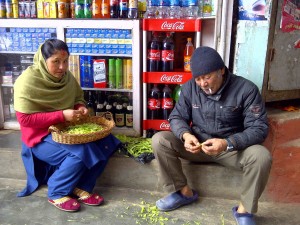We had spent the day in the area, visiting some local NGOs, schools, and getting a sense of how people lived. In Bara, a few days into our time in Nepal, we had the opportunity to visit a cluster of huts that live in very underprivileged region, of a majority of Dalit families. When the sun started setting, we decided to walk through the village, trying to talk to some locals and ask them about their lives and experiences, to get a pulse of the challenges to peacebuilding in that area.
A woman sitting by the fire outside had caught our attention. The pitch dark was surrounding us, we had turned off our flashlights and the only source shining some light came from a small fire in the middle of the ground. I think it was because she was not inside any hut, shielding the cold away, but rather sitting outside, in front of her husband and surrounded by her eight children. I cant put my finger on her age; she might have been 35 or 40, but the years of strenuous life and poor health made her look at least 20 years older.
She was kind enough to open up to us. Since we were only 3 kilometers from the Indian border, she spoke Hindi, which meant that Professor Iyer directly to her, overpassing our male translators which has sometimes hinder communication and trust when interpreting the answers and questions. We would whisper questions and doubts to our teacher’s ear while she would casually include them in the conversation she was having with her.
She told the story of her life, but being a Dalit landless woman in a remote cluster in southern Nepal, you can start getting an idea of the strains and struggles she has dealt with since the very day she was born. She worked in the fields nearby, not for money but for food, for about 16 hours a day. She would work the equivalent of hours to 4kgs of rice a week, but would only receive 2kgs to bring back home. Having nine mouths to feed on 2kgs of rice a week is extremely hard. Of her eight children, only one went to school, the older male… no surprise there!
She explained in detail the hardships of living as a landless family in this area of the country. She explained told us about daily living activities, how she struggles being a woman, the discrimination imposed by society, by her village, by her own family. A small cold for instance, can prove mortal, with a high probability of complicating simple ailments was so dangerous because there was no way to pay any health services, with the hospital being miles away.
I wish I could convey the image of the process in which these conversations took place. A woman squatting in front of a fire, trying to keep her hands warm, surrounded by all her children, all trying to huddle together for body heat, with her children squishing close together, hands extended over the small flames. As we grew close, so did the curious villagers around us, creating an arena like scenario, with the woman being the center of attention and interaction. Every once an again an elder would erupt in shouts about how unfair and how hard was life.
These experiences touched me deeply. I left the cluster feeling very moved; very emotional. We weren’t witnessing a tragedy, she wasn’t crying or pleading for money. But how to explain that the situation would change for her, or maybe for her children? How can we give her some hope that her children, or her daughters, would link out of this highly dangerous and disheartened cycle? It also made me think of the poverty in my country, where the roots, causes and consequences were worlds apart from what we had just witnessed. Essentially, some say that poverty is poverty; an empty stomach here in Nepal and an empty stomach in Venezuela is the same – but it’s the idea of ‘hope’ that I’ve been twirling my head around. This woman we had met was not to blame for being born a Dalit, for being born a woman…. There is no escape from the cycle she was born into. The layers of conflict and inequality that this woman is a victim of are so complex and thick, that I see it impossible to convey some message of hope or optimism. The levels of structural violence were weighing over her back like a ton of bricks would have to come down one by one, very slowly, over time. Maybe she won’t see the changes, and even her daughters won’t either, but who knows… Lets leave some hope for the future.




